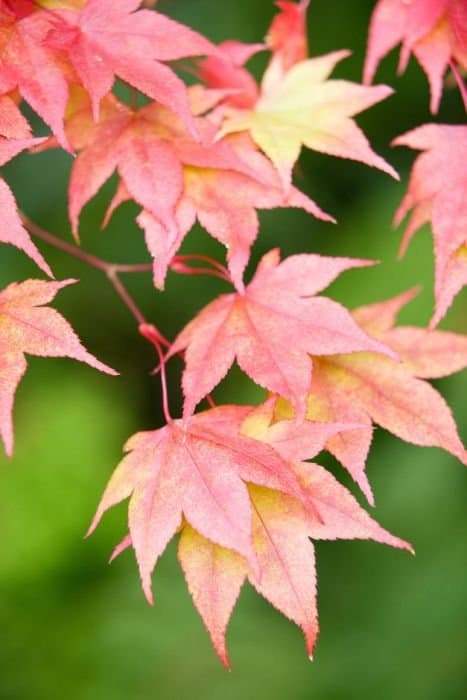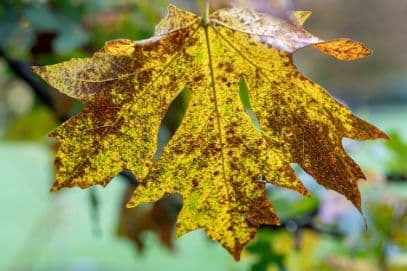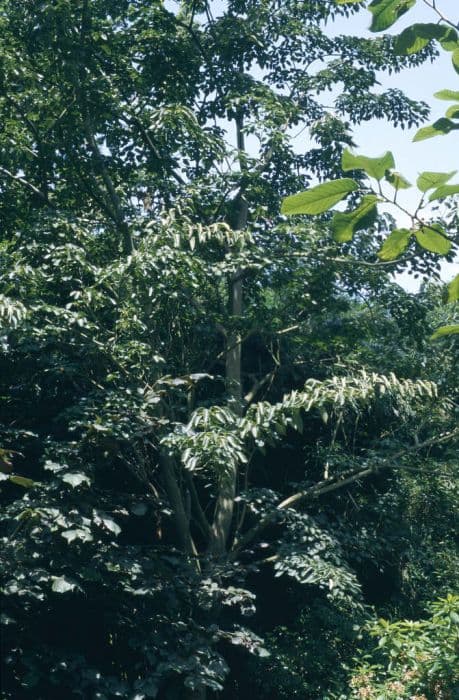Japanese Maple Acer palmatum 'Peaches and Cream' (M/v)

ABOUT
The Japanese maple known as 'Peaches and Cream' has a striking appearance that showcases a blend of colors in its foliage. The leaves are primarily a soft, creamy yellow with varying shades of peachy-pinks, oranges, and hints of green. This variegation creates a delicate and colorful mosaic which evolves through the seasons. Each leaf is finely cut and ornately shaped, having multiple lobes that radiate outwards, giving a look reminiscent of an open hand with fingers. The edges of the leaves are slightly serrated, adding texture to its appearance. As the seasons change, the colors of the leaves may intensify, with the creamy hues becoming a bolder yellow, and the peaches and oranges deepening, adding warmth to the display. New growth often emerges with a more pronounced pink coloring, gradually blending into the cream and green as the leaves mature. The bark and branches offer a subtle contrast, with a smooth texture and a color that may range from a soft gray to a gentle brown, providing a muted backdrop that allows the foliage to truly stand out. The overall look of the Japanese maple 'Peaches and Cream' is one of a visually soft yet vibrant living sculpture, with its delicate foliage colors forming a palette that complements many garden designs.
About this plant
 Names
NamesFamily
Sapindaceae.
Synonyms
Japanese Maple, Smooth Japanese Maple, Palmate Maple.
Common names
Acer palmatum 'Peaches and Cream'.
 Toxicity
ToxicityTo humans
The Japanese maple is generally considered to be non-toxic to humans. There are no significant reports of poisoning from ingestion of this plant's parts. However, as with any plant material, individual allergic reactions or irritation could occur if ingested or handled.
To pets
The Japanese maple is not known to be toxic to pets. It is considered to be relatively safe for dogs, cats, and other animals if they happen to ingest its leaves or seeds. No particular symptoms of poisoning are generally associated with this plant. However, it's always prudent to prevent pets from eating large amounts of any non-food plant material, as it can potentially cause gastrointestinal upset or blockage.
 Characteristics
CharacteristicsLife cycle
Perennials
Foliage type
Deciduous
Color of leaves
Variegated
Height
6-8 feet (1.8-2.4 meters)
Spread
5-7 feet (1.5-2.1 meters)
Plant type
Tree
Hardiness zones
5-8
Native area
Japan
Benefits
 General Benefits
General Benefits- Ornamental Appeal: The 'Peaches and Cream' Japanese maple is highly valued for its aesthetic beauty due to its unique peachy-cream and green variegated leaves, making it a stunning focal point in any garden.
- Seasonal Interest: This cultivar offers year-round interest with its changing foliage colors, from the variegated leaves in spring and summer to the dramatic shades of red and orange in the fall.
- Shade Tolerance: It can thrive in partial shade, making it a great choice for gardens with varying light conditions or beneath the canopy of larger trees.
- Compact Size: The tree has a small, compact stature, making it suitable for smaller gardens or spaces where a full-size tree would be too large.
- Low Maintenance: Once established, it requires minimal care beyond occasional pruning to maintain its shape and general health.
- Japanese Garden Style: Its traditional Japanese aesthetic fits perfectly in Japanese-themed gardens or as part of a Zen landscaping project.
- Wildlife Attraction: Though not its primary benefit, it can still attract birds that appreciate the tree's structure for nesting or perching.
- Privacy Screening: When planted in groups, the trees can form a dense canopy that provides a certain degree of privacy.
- Tolerant of Pruning: It responds well to pruning, allowing gardeners to shape the tree to their liking or to engage in the art of bonsai.
 Medical Properties
Medical PropertiesThis plant is not used for medical purposes.
 Air-purifying Qualities
Air-purifying QualitiesThis plant is not specifically known for air purifying qualities.
 Other Uses
Other Uses- Crafting Bonsai: The Japanese Maple 'Peaches and Cream' can be trained into a miniature form through bonsai techniques, making it a popular choice for enthusiasts of this delicate art.
- Photography Subject: Its unique foliage coloration makes it a striking subject for photographers seeking to capture the beauty of plants and gardens.
- Educational Tool: Horticulture teachers may use 'Peaches and Cream' as a live example to illustrate pruning techniques and tree physiology to students.
- Leaf Castings: Artists and gardeners can use the leaves of 'Peaches and Cream' to make decorative concrete or plaster castings, showcasing their intricate shape and veining.
- Themed Gardens: It can be incorporated into culturally specific gardens, such as Japanese Zen gardens, to create an immersive aesthetic experience.
- Marquetry and Inlay Work: Skilled woodworkers might use the leaves as templates or inspiration for intricate inlay work on fine furniture.
- Culinary Presentation: While not edible, the leaves may be used as natural, decorative elements in presenting gourmet dishes or plating in high-end culinary establishments.
- Seasonal Decor: Branch clippings, especially during the fall when colors are vivid, can be used in floristry or seasonal tablescapes.
- Wildlife Habitat: It can provide habitat and nesting sites for birds and other small wildlife within a garden setting.
- Ink Making: Creative individuals might experiment with creating natural inks or dyes from the fallen leaves of 'Peaches and Cream' for art and craft projects.
Interesting Facts
 Feng Shui
Feng ShuiThe Japanese Maple is not specifically used in Feng Shui practice.
 Zodiac Sign Compitability
Zodiac Sign CompitabilityThe Japanese Maple is not used in astrology practice.
 Plant Symbolism
Plant Symbolism- Beauty and Elegance: The Japanese Maple, known for its aesthetically pleasing leaves and organic design, symbolizes beauty and grace in the natural world.
- Peace and Serenity: With its calming presence, the Japanese Maple is often associated with tranquility and peacefulness, making it a common plant in traditional Japanese gardens.
- Balancing Elements: Due to its origin in Japan, where gardens are designed to create harmony between the elements, the Japanese Maple represents balance and harmony in life.
- Enduring Friendship: In certain cultural contexts, the Japanese Maple, because of its longevity and steadfastness, symbolizes enduring friendship and loyalty.
- Change and Transition: Reflecting the changing seasons with its foliage that shifts in color, the Japanese Maple is emblematic of embracing change and the passage of time.
 Water
WaterThe Japanese Maple should be watered thoroughly, allowing the top inch of soil to dry out between waterings. Deep waterings are preferable to frequent, shallow ones to encourage root growth. During active growth in spring and summer, water approximately once a week, but this can vary based on climate and soil conditions. You might need to provide about 2 gallons every week during dry periods, making sure not to overwater as these trees do not like soggy roots.
 Light
LightThe Japanese Maple thrives in a location with dappled sunlight; too much direct sun can scorch the delicate leaves, especially during the hotter part of the day. Morning sun with afternoon shade or filtered sunlight is ideal to maintain the vibrant colors of the 'Peaches and Cream' variety without causing leaf burn.
 Temperature
TemperatureThe Japanese Maple prefers temperatures ranging from 60°F to 80°F but can tolerate a range from about 20°F to 90°F. The ideal conditions would be consistent, moderate temperatures without the extremes of either frost or intense heat. Protecting the plant from harsh winter conditions and extreme summer heat is important for its overall health.
 Pruning
PruningPrune the Japanese Maple to maintain its shape and remove any dead or diseased wood. Pruning is best done in late winter or early spring before new growth begins. Light thinning of the canopy to allow light and air to penetrate is also beneficial and should be done periodically, but avoid heavy pruning as it can stimulate excessive new growth.
 Cleaning
CleaningAs needed
 Soil
SoilJapanese Maple 'Peaches and Cream' thrives in well-draining soil rich in organic matter with a pH between 5.5 and 6.5. A mixture of one part peat, one part pine bark, and one part coarse sand or perlite would make an ideal soil medium for this ornamental tree.
 Repotting
RepottingJapanese Maple 'Peaches and Cream' typically requires repotting every two to three years, or when it becomes root-bound. It's best to repot in the early spring before the growing season begins.
 Humidity & Misting
Humidity & MistingJapanese Maple 'Peaches and Cream' prefers moderate to high humidity levels but is adaptable to average outdoor humidity. Strive to maintain an environment that is not too dry to prevent leaf scorch.
 Suitable locations
Suitable locationsIndoor
Place in bright indirect light, keep humid, and protect from drafts.
Outdoor
Part shade to full sun, protect from harsh winds, well-draining soil.
Hardiness zone
5-8 USDA
 Life cycle
Life cycleThe Japanese Maple 'Peaches and Cream' begins its life cycle with seed germination, where the stratified seeds sprout when exposed to the right temperature and moisture conditions. Following germination, the seedling stage involves the establishment of the root system and first true leaves, typically under the care of a plant nursery. During the sapling stage, the tree develops a more robust stem structure and increased foliage as it becomes acclimated to its planting location, whether in a garden or container. As it reaches maturity, the Japanese Maple 'Peaches and Cream' showcases its ornamental value with variegated leaves that display a mix of green and creamy white, often tinged with pink during the spring growth flush. This stage can last many years, with the maple needing seasonal maintenance like pruning, watering, and fertilization. Ultimately, towards the end of its lifecycle, the tree will experience a decline in vigor, which can be due to old age, environmental stress, or disease, eventually leading to its death after potentially several decades in favorable conditions.
 Propogation
PropogationPropogation time
Late winter-early spring
The Japanese Maple 'Peaches and Cream' is commonly propagated by grafting, which is the most popular method for this type of plant due to the preservation of the cultivar characteristics. Grafting is usually done in late winter or early spring before the sap starts to flow. Scion wood is collected from healthy branches of the 'Peaches and Cream' variety and grafted onto the rootstock of a hardy Acer palmatum species. The scion wood should be about 2 to 6 inches long (5 to 15 cm) with at least two or three buds. After making a slanting cut on both the scion and the rootstock, the two pieces are joined together and secured with grafting tape to ensure they stay in place, allowing the vascular tissues to fuse as the graft heals.







![Shirasawa maple [Moonrise]](/_next/image?url=https%3A%2F%2Fplants-admin.emdemapps.com%2Fimages%2Fplants%2F%2Fimages%2F604b5dde58337.png&w=640&q=75)

